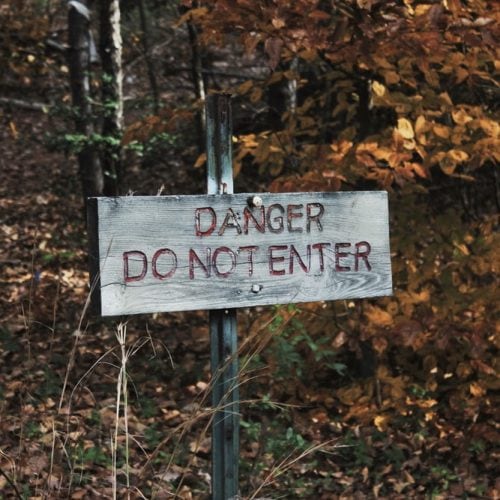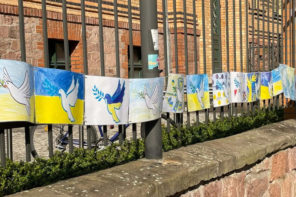As neo-nationalists gain strength across Europe and the promise of ‘strong’ borders continues to gain traction with electorates across the world, we need few reminders of the paradoxes of globalisation. In the present moment we live in a world of both blurred boundaries and hard walls. This simultaneous rigidity and flexibility which characterise the contemporary moment are, of course, not contradictory but co-constitutive. Tracing the production of ‘danger zones’, ‘No Go World’ explores these tensions and shows how at a time of ever-increasing possibility for global connectivity, disconnection and distance appear to be triumphing. Western military and aid interventions are increasingly conducted through remote and indirect means, while the borders of rich nations are closing in.
‘No Go World’ takes us to the red zones of the World Threat Map, to places our governments strongly advise us not to visit and where university bureaucracies refuse to clear new research.
The construction of ‘no go zones’, however, is not a benign process enacted by nation-states in order to protect their citizens but, as Andersson argues, an intensely political act that has multiple functions and outcomes.
This book vividly traces how these processes play out, and in whose interests.
Much like Andersson’s first book, ‘Illegality Inc’, ‘No Go World’ is not a traditional anthropological ethnography. Andersson aims to show the systemic way in which fear is shaping the world around us. His means of doing so is by conducting multi-sited research which draws on a range of interviews, military reports, maps, journalistic accounts and more traditional ‘hanging out’. While this results in less in-depth and intimate portrayals of individual people, it allows Andersson to demonstrate the range of actors and organisations involved in the systemic production of fear and the connections between them. Like the best anthropological work, ‘No Go World’ elucidates the dynamic connections between micro, local processes and macro, global ones. It highlights how structure, agency and ideas all play important roles in shaping the world. In spite of his mobile roving ethnographic eye, Andersson’s evocative writing ensures there is no shortage of memorable characters. That he also puts himself in the text not only increases the book’s readability, but also acts as a useful reminder that we are all implicated in military, humanitarian and border interventions, and the justifications upon which they are based.
‘No Go World’ is divided into two parts. The first – The Story of the Map – is about the map of danger and its ‘quest for control and separation’ (18). It comprises chapters which highlight the processes through which particular areas of the world are being made to be distant and disconnected. In these chapters we move from Stockholm to Timbuktu, hearing from military heads of peacekeeping missions to seasoned aid workers, and reflect on the history of ‘Mali’s messy interventions’ (50). Andersson’s astute analysis highlights the consequences of risk-aversion tactics which turn the north of Mali into a ‘no go zone’ and ultimately produce more danger rather than less. The chapters in the second part – Contagion – illustrate the impossibility of the former undertaking, and show how, inevitably, ‘the map’s red and green zones bleed into one another’ (141). Examining borders, migration, the aid industry and those who inhabit the ‘no go zones,’ these chapters highlight the circular nature of fear, risk and danger.
While ‘No Go World’ draws on insights from a range of disciplines, Andersson stays true to the anthropological project of illuminating that which lies beneath the surface through his minute tracking of the consequences of fighting ‘danger’ with distance. In recent years, the nature of military operations has significantly changed. Boots on the ground (or at least Western ones) have been replaced by remote controlled weapons and surveillance systems. As a result, security in these circumscribed danger zones has been outsourced to a booming private military industry, while there has been a huge surge in the market for drones and similar weapons. The consequences, as Andersson documents, are not only economic. Social as well as physical distances are created. In the absence of mass peace-keeping missions, local soldiers are trained and deployed to shoulder the dangerous work. It is not only these actors who undertake the ‘risky and dirty tasks’ (11) in the demarcated ‘danger zones’, but also local aid workers, mercenaries and freelancers. This creates a racialised division of labour which maps onto the former coloniser and colonised relationship.
Moving from on the ground effects to broader consequences, Andersson illuminates the ‘performative power’ of the mapping of danger which, as he writes, ‘serves potent functions for both insurgents and Western interveners, who wittingly or unwittingly collude in reinforcing the danger zone in its distance and strangeness’ (82). The interests of multiple and divergent groups can be simultaneously met. Violent groups celebrate the mass withdrawal of tourism which inevitably ensures the creation of ‘danger zones’, as the connections between local populations and foreigners are severed. For Western states, meanwhile, the ‘apolitical tool of travel advice’ (81) can surreptitiously work to force cooperation on key political objectives with foreign governments.
The great strength of ‘No Go Zone’ is the way in which it effortlessly traverses from the local to the global, highlighting danger’s systemic, rather than geographic, nature.
This goes to the heart of ‘No Go World’s’ central argument: that danger and fear (its response) are self-reinforcing and circular, and that distance designed to contain danger actually makes the world more dangerous.
This argument is crystallised in Chapter Five – The Snake Merchants – which centres on the ‘fear market.’ ‘In order to be rich, you have to threaten,’ says Djibril, president of a Malian association for ‘returnee’ migrants. Djibril had been working on and off with development projects for several years but since 2012, when the conflict in Mali began, donors and Western NGOs have disappeared. Foreign money now came in response to potential dangers and Djibril’s above comment highlights how development needed to be ‘framed as a security concern’ (177) in order to attract funding. Focusing on the aid industry, in this chapter Andersson shows how fear has become a marketable resource with ‘jihadists, media outlets, smugglers, security forces, and repressive and democratic regimes all vying for different corners of the marketplace’ (194). But, as he points out, the escalation of dangerisation has led to a self-reinforcing feedback loop that ultimately produces more danger and fear. While this chapter focuses on the aid industry, the concept of a self-reinforcing feedback loop reflects Andersson’s broader argument. Danger zones are produced as dangerous by labelling them so. Distance does not produce safety but greater danger and fear and, as Andersson illustrates, this can be in the interest – even if only in the short-term – of a diverse range of actors and groups from aid organisations to Western governments, jihadist fighters and many others. Conversely, therefore, while disconnection and distance are the main subject of this book, its central argument is about connectedness and circularity: ‘the danger zone is not out there: it is already with us’ (248).
Perhaps the most poignant aspect of the book is its illustration of the unequal nature of these connections and disconnections. The story of outsourcing and of a poorly paid and precariously employed workforce is one all too familiar in the contemporary neoliberal world. Local soldiers and aid workers, as well as the freelance journalists undertaking dangerous and poorly remunerated work, occupy the same structural position as sweat-shop and call-centre workers in the global south or precariously employed migrants in the global north. These different groups are connected through their shared position at the sharp end of global capitalism. Their situations are produced by the global flows and connections which characterise our contemporary world, but their circumstances reflect the way in which these flows do not run evenly, but rather become disrupted, blocked and impeded by the unequal mapping of power.
Ruben Andersson. 2019. No Go World How Fear Is Redrawing Our Maps and Infecting Our Politics. University of California Press.










I pass that and enter it the no go world